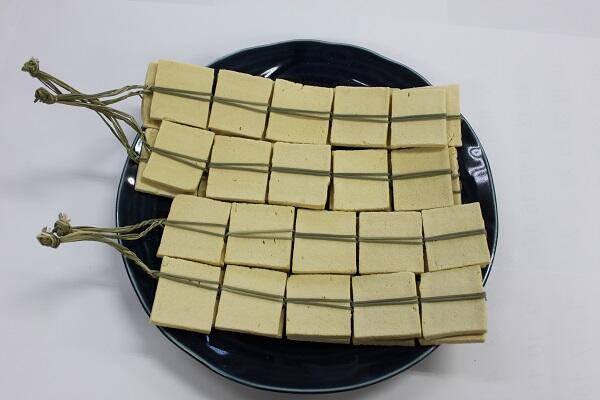Iwadeyama Koridofu
| Registration Number | 65 |
|---|---|
| Name of the GI | Iwadeyama Koridofu |
| Class | Processed Foodstuffs |
| Date of Protection | 2018/08/06 |
| Producing Area |
Miyagi Prefecture
Iwadeyama, Osaki City |
| Applicant - Name and Address | JA Shinmiyagi 43-1, Daigahara, Tsukidate Aza Terukoshi, Kurihara City, Miyagi Prefecture |
Producing Area
Iwadeyama Koridofu is a freeze dried tofu (bean curd) characterized by its elastic, firm, and smooth texture.
The unique process of making Iwadeyama Koridofu minimizes miscellaneous flavor and brings out the rich taste of soy, along with the white and smooth texture in appearance.
Iwadeyama Koridofu maintains its shape and firmness when cooked and soaks up broth well, which makes it an invaluable traditional ingredient in the local cuisine. It is highly recognized for its quality, and is traded at a price more than twice as high as that of general frozen tofu.
The first step in producing Iwadeyama Koridofu is to make tofu using nigari (bittern) and soybeans grown in Miyagi Prefecture as its only ingredients. The prepared tofu is sliced into 5-cm squares, which are then aged for about 15 days in a freezer at a temperature of approximately -3 °C.
After the first aging, tofu slices are thawed in water and drained to remove harshness and miscellaneous flavor, which is followed by the second aging in a freezer.
The aged tofu slices are then dried in the open air or in a drying chamber.
The finished products undergo visual inspection to exclude ones that are out of shape, and are screened for contaminants using a metal detector.
The entire production process described above takes place in Iwadeyama.
The producing area of Iwadeyama Koridofu, Iwadeyama, is located on the east side of the Ou Mountains (1) and is exposed to dry and severe cold, but has less snowfall and less strong wind than the surrounding areas. It is vital to avoid humidity and strong wind, for producing frozen tofu, and the producing area has suitable climatic condition.
Production of Iwadeyama Koridofu is recognized as a local traditional industry that is described in the records from the Meiji era (2), with 86 producers at its peak in 1960. Though only 5 producers remain today, they maintain an annual production of approximately 100,000 packages, with following the original production method of Iwadeyama Koridofu that has been passed down.
Iwadeyama Koridofu is an invaluable ingredient in the local cuisine and other dishes such as oden (3) and hotpots, and particularly essential for Sendai zoni (mochi soup) (4)(5), which is eaten on New Year's Day.
- Ou Mountains: The longest mountain range in Japan that stretches approximately 500 kilometers through the center of the Tohoku region of Japan. The range runs from Aomori Prefecture through Iwate, Akita, Miyagi, Yamagata, and Fukushima Prefectures before reaching Tochigi Prefecture.
- Meiji era: An era of Japanese history extending from 1868 to 1912, during which Japan shifted from feudalism under the Shogunate to a modernized nation state.
- Oden: A typical Japanese hotpot cooked at home and restaurants, prepared by stewing ingredients such as tofu, ganmodoki (fried bean curd cake with vegetables), konnyaku (konjac), hanpen (fish cake made by mixing pounded fish with Japanese Yam before boiling), potatoes, and daikon (Japanese radish) in a broth flavored with soy sauce or miso. The recipe varies according to region.
- Zoni: A soup prepared by simmering mochi (rice cake) with ingredients such as vegetables, chicken, seafood, fish paste, and soy products, traditionally eaten during sanganichi, the first three days of the Japanese New Year, to celebrate the New Year.
- Sendai zoni: Zoni made in the Sendai region prepared by cooking ingredients such as shredded daikon, carrot, and burdock root in a stock made from grilled and dried goby and flavored with soy sauce. The dish is characteristically garnished with the grilled goby used to prepare the stock.


